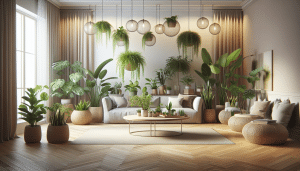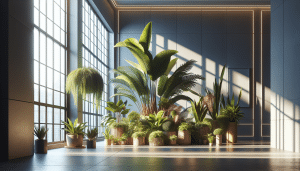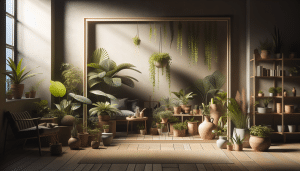You Can Transform Shade Gardens With These Lush Solutions
Daniel Fisher September 5, 2025
Bringing any shady corner to life is possible with the right garden strategies. Explore how selecting shade-tolerant plants, smart design, and simple soil improvements help homeowners create lush, vibrant gardens in areas often thought impossible for growth.
Understanding Shade in Your Home Landscape
Every homeowner faces a challenge when it comes to shaded areas on their property. Not all spaces enjoy full sun, and many gardens are dominated by tall trees or buildings casting long shadows. Understanding the differences in shade – whether it’s partial, dappled, or deep – is the first key step toward a thriving shade garden. Environments with filtered sunlight can foster unique microclimates supporting moisture-loving plants and cooling groundcover. These spots may actually provide advantages, such as reduced evaporation and lower watering needs, compared with sun-drenched lawns. Recognizing and measuring levels of light helps homeowners make better plant selections for shaded areas, preventing disappointment and boosting long-term success. (Source: https://hgic.clemson.edu/factsheet/gardening-in-shade/)
Shade is rarely uniform throughout the day. A spot shielded from direct light at noon might still get sun in the morning or evening. Observing changes in light intensity allows gardeners to match plant needs more precisely to their chosen environment. Many shade-loving varieties will even fail if sunlight is lacking altogether, so being aware of subtle shifts is crucial. With attention and patience, it becomes possible to categorize zones as ‘light,’ ‘medium,’ or ‘heavy’ shade and plan accordingly. Knowledge of these zones creates the foundation for a shade garden to flourish.
Creating a lush home garden in the shade opens doors for beauty that is unique to low-light environments. Cool, moist conditions favor the development of delicate foliage, woodland wildflowers, and uniquely textured groundcovers. By starting with shade assessment, you cultivate a deeper appreciation for the natural diversity your landscape already offers. This makes each planting decision more intentional, leading to better performance and a striking aesthetic.
Shade-Loving Plants That Deliver Bold Color and Texture
One exciting aspect of home gardening is discovering just how many plants thrive without full sun. Foliage plants like hostas, ferns, coral bells, and astilbes bring deep greens, silvery blues, and vibrant red hues to dark corners. Additionally, many ferns add visual interest year-round due to their unique leaf structure. These plants typically require less maintenance than sun-lovers because their water needs are lower and they’re less likely to face leaf scorch. Integrating these selections helps build a layered look that is both healthy and attractive. (Source: https://hgic.clemson.edu/factsheet/shade-loving-plants/)
Some flowering perennials also thrive in shade, including foxgloves, bleeding hearts, and Japanese anemones. These plants offer splashes of color that contrast beautifully with the complex foliage of hostas and ferns. When grouped in clusters, their blossoms stand out even in dimly lit garden beds. Gardening enthusiasts can even experiment with annuals or bulbs, such as impatiens and caladiums, to create a vibrant underplanting that lasts one growing season. The secret is to focus on species known for performing well in less than optimal lighting.
Texture is another design element shade gardeners can maximize. Large-leaf hostas provide a bold backdrop for delicate woodland wildflowers. Low-growing groundcovers like ajuga or sweet woodruff add softness, filling in gaps and preventing weed growth. Mixing and matching these varieties gives shady zones much-needed contrast and visual depth, ensuring the garden looks lush and intentional even when flowering is sporadic.
Improving Soil for Vibrant Shade Gardens
Healthy shade gardens begin with healthy soil. Shady spots beneath trees or along houses often suffer from poor soil quality, as tree roots compete for nutrients and moisture. Amending existing garden soil with organic matter, such as compost or well-rotted manure, restores fertility and improves drainage. This enriched soil retains moisture better, supporting ferns, hostas, and other shade-tolerant species. Layering mulch over the surface also shields roots from sudden temperature swings and reduces evaporation, which is especially valuable in pockets of dry shade. (Source: https://extension.umn.edu/planting-and-growing-guides/shade-gardening)
In some shady home garden locations, compacted soil becomes a problem over time. Compaction decreases oxygen availability for roots and can make it difficult for water to penetrate. To counteract this, periodic aeration and light tilling are beneficial. Landscape professionals recommend gently loosening soil every few seasons in high-traffic or heavily shaded areas. Over time, this improves plant health, root development, and water infiltration, reducing long-term maintenance headaches.
Many homeowners find raised beds or containers useful for growing shade plants when in-ground conditions are poor or tree competition is too strong. Containers filled with premium soil create small microenvironments ideal for shade plants. These solutions add flexibility, allow for specialized mixes, and offer the possibility to relocate plants for maximum enjoyment during the growing season. Always remember—great shade gardens are built on a strong foundation of nutrient-rich, well-draining earth.
Design Tips for Creating Beautiful Shade Retreats
Designing a shade garden is about celebrating foliage, texture, and form over bright blooms. Strategic placement of plants in layers, from tall shrubs to low-growing groundcovers, creates a rich tapestry of greens and accent colors. Curved garden borders, winding pathways, or small water features bring structure and a sense of tranquility to shaded spaces. Incorporating hardscape elements like benches or rustic stepping stones gives visitors a place to pause and admire subtle beauty. Good planning ensures interest across seasons even when flowers are not at their peak. (Source: https://www.missouribotanicalgarden.org/gardens-gardening/your-garden/help-for-the-home-gardener/advice-tips-resources/gardening-help-faqs/gardening-in-shade.aspx)
Color in a shady home garden often comes from foliage rather than flowers. Gold, silver, and chartreuse leaves catch and reflect available light, creating bright spots in dim corners. Gardeners can use lighter-colored stones, painted pots, or reflective décor to maximize brightness and visual contrast. Repetition of patterns—such as groups of hostas arranged along a path—helps tie the garden together, providing order and unity without feeling overly formal. These design strategies help transform a once-forgotten area into a destination worth experiencing.
Don’t overlook vertical interest. Shade-loving climbing plants, such as ivy or climbing hydrangea, can soften fences and walls, adding background depth. Hanging baskets or wall-mounted planters offer further options for bringing greenery to eye level. By embracing multi-layer design, homeowners ensure their shade garden feels balanced, lush, and thoughtfully curated from every angle.
Maintenance Considerations for Long-Term Shade Garden Success
It’s common to assume shady gardens require less care, but they come with their own set of unique maintenance needs. Regular mulching controls weeds, conserves moisture, and nourishes the soil. Periodic pruning of overhanging tree branches helps manage shade levels and encourages optimal light penetration. Removing weeds early in the season stops them from overwhelming groundcovers and other delicate shade plants. These steps keep a shade garden healthy and looking its best. (Source: https://extension.psu.edu/shade-gardening-in-pennsylvania)
Watering requirements vary based on soil conditions, but shade gardens are not immune to drought. Tree competition for moisture can leave even ferns wilting in summer’s peak. Checking the soil regularly ensures plants are hydrated without becoming waterlogged. Applying a slow-release fertilizer each spring supports lush foliage, but over-fertilization can actually harm shade-adapted species. A balanced and moderate approach yields greener, more resilient gardens year after year.
Monitoring for pests and disease is also essential, even in shaded environments. Many insects prefer cool, damp conditions to breed, so prompt removal of fallen leaves and debris minimizes problems. Encouraging healthy airflow and spacing plants appropriately reduces mildew and fungal risks, best promoting longevity for prized shade garden specimens.
Creative Features That Elevate Home Shade Gardens
For homeowners craving something extra, adding creative structures or accents can help turn shade gardens into unique backyard retreats. Simple additions like a mossy stone bench, birdbath, or small sculpture provide focal points that encourage exploration. Water features such as small waterfalls or trickling fountains help mask noise and create a peaceful atmosphere, making the garden a true place of respite. (Source: https://www.gardeners.com/how-to/shade-garden-design/8825.html)
Lighting is another element that can dramatically change the feel of a shade garden at dusk. Well-placed solar lanterns, uplights, or fairy lights along pathways make evening strolls magical, extending the enjoyment of outdoor living space. Homeowners might even experiment with glow-in-the-dark stones or artistic planters to add playful touches.
Wildlife-friendly options such as shade-tolerant native flowers or understory shrubs help support bees, butterflies, and birds. Building a naturalistic pond or installing a habitat log pile attracts beneficial creatures, enriching the biodiversity of the shade garden. These creative features add depth and personal flair while supporting a peaceful, eco-friendly home ecosystem.
References
1. Clemson Cooperative Extension. (n.d.). Gardening in shade. Retrieved from https://hgic.clemson.edu/factsheet/gardening-in-shade/
2. Clemson Cooperative Extension. (n.d.). Shade-loving plants. Retrieved from https://hgic.clemson.edu/factsheet/shade-loving-plants/
3. University of Minnesota Extension. (n.d.). Shade gardening. Retrieved from https://extension.umn.edu/planting-and-growing-guides/shade-gardening
4. Missouri Botanical Garden. (n.d.). Gardening in shade. Retrieved from https://www.missouribotanicalgarden.org/gardens-gardening/your-garden/help-for-the-home-gardener/advice-tips-resources/gardening-help-faqs/gardening-in-shade.aspx
5. Penn State Extension. (2017). Shade gardening in Pennsylvania. Retrieved from https://extension.psu.edu/shade-gardening-in-pennsylvania
6. Gardener’s Supply Company. (n.d.). Shade garden design. Retrieved from https://www.gardeners.com/how-to/shade-garden-design/8825.html








